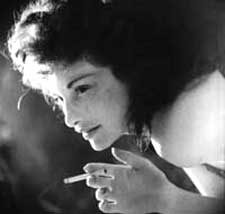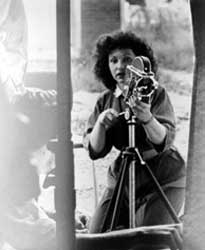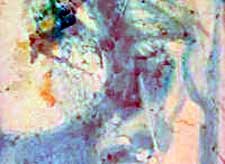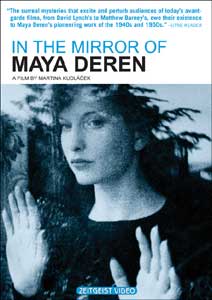 Maya Deren, the great avant garde filmmaker, died in 1961 at age 44 from a brain hemorrhage brought on most likely by inherited high blood pressure & an addiction to emphetimines, which she injected regularly & called her "cocktail," convincing herself it was the equivalent of vitamins since it gave her such extraordinary energy.
Maya Deren, the great avant garde filmmaker, died in 1961 at age 44 from a brain hemorrhage brought on most likely by inherited high blood pressure & an addiction to emphetimines, which she injected regularly & called her "cocktail," convincing herself it was the equivalent of vitamins since it gave her such extraordinary energy.
Her speed addiction would also explain her sometimes eratic behavior. For instance, although a tiny woman, she once became so angry that she tossed a refrigerator across the kitchen while at a friend's wedding.
Her addiction was encouraged, perhaps actually caused, by one Dr. Max Jacobson who serviced the addictions of many dancers, artists, & performers in New York City. He lost his license to practice medicine over such activity in 1975, though he should have been tried in a criminal court for malicious disregard for human life.
Maya was cremated & her ashes buried by Teiji on Mount Fuji in Japan, on the side of the mountain overlooking the sea.
In her lifetime she had become a leading member of the American avant garde. She fought & publicly criticized the Hollywood system for its monopology on theatrical outlets & for squashing independent cinema & film as art. Since 1986, the American Film Institute has given the Maya Deren Award in recognition of achievement in independent filmmaking.
 Austrian documentarian Martina Kudlacek came to America to conduct interviews & pursue her well-chosen topic, the life & art of Maya Deren, resulting in an extraordinary record of an extraordinary woman In the Mirror of Maya Deren (2002). Austrian documentarian Martina Kudlacek came to America to conduct interviews & pursue her well-chosen topic, the life & art of Maya Deren, resulting in an extraordinary record of an extraordinary woman In the Mirror of Maya Deren (2002).
It's something of a "sequel" to Kudlacek's earlier documentary on Maya's second husband, Czech photographer & subject of Aimless Walk: Alexander Hammid (1996). And it's a companion-documentary to her study of another woman avant garde filmmaker, Notes on Marie Menken (2006).
A fixture of Greenwich Village of the 1940s, she was a formative figure for the Beat Generation artists & mother of avant garde cinema in America, an inspiration to the Warhol circle that would arise in her wake.
There are many highlights to this biography, including snippits of Maya talking about her films, wire recordings of her lectures. Since her films are silent I had no clue what she sounded like, but certainly never imagined this petite beauty had the voice of Lucy Recardo. Good thing the films were silent! Yet when she sings, I rather like that voice.
How unfortunate her third husband Teiji Ito had died just before Martina began this project. We see him only in vintage footage, a kind of Japanese James Dean who married a woman considerably older. Among the interviewees, we hear from choreographer Katherine Dunham for whom Maya worked as personal secretary. Dunham believed Maya could've been a fine dancer, but lacked the focus, having too many other interests to devote herself to dance.
Rita Christiani is interviewed; she was one of the stars of Maya's Ritual in Transferred Time (1946), & her insights on the film, & her feelings about Maya, are intellectual & touching.
Very personal & sweet commentary is provided by her second husband Sasha Hammid, & by Beat generation actress Judith Malina, & other contemporaries. Most thrilling was the documentarian's trip to Haiti where she was able to interviews with a voudoun priest who was Maya's friend & adviser, & the priestess who was Maya's translator when she was in filming her anthropological work Divine Horsemen posthumously released in 1977.
Maya's first "trance films" led smoothly into her interest in voudoun, & she gained access to elements of the faith most white filmmakers would never see because she with deep devotion came to serve the gods & participate in ritual & observance. When possessed, it was by Erzuli the Goddess of Love (patroness also of the arts). And her Haitian friends clearly remember her as a woman of power & really cared about her.
Included in the documentary are some marvelous film fragments, most interestingly from the unfinished Ritual & Ordeal including the sequence "Lascivious Folk Ballet, with Maya singing a bluesy song that is damnably close to rock 'n' roll, with the amusing & cool lyrics: I got stones in my head/ I got pebbles in my bed/ In my head they rattle/ In my head they pound/ Cant ya hear 'em/ Stones/ Stones."
From her lecture recordings we'll also hear her singing a vooodoo song very beautifully. A little sound-bite of Teiji singing is equally lovely, & if I have any lament about this film, it is that we couldn't have more of Teiji, a fascinating artist whose devotion to Maya has romantic appeal.
 One goofy guy she interviewed was Maya's friend & fellow avant garde filmmaker Stan Brakhage. The documentary doesn't mention what a hack he's been pumping out several really pathetic avant garde films each year.
One goofy guy she interviewed was Maya's friend & fellow avant garde filmmaker Stan Brakhage. The documentary doesn't mention what a hack he's been pumping out several really pathetic avant garde films each year.
He dashes off Water for Maya (2000) to comnmemorate the filming of In the Mirror of Maya Deren. While being interviewed, in clever self-promotion, he is painting film cells & bragging that he's painting the cells mostly blue in honor of Maya who loved water.
Among the extras ona the dvd, this awful film is included. Stan's dead now so I can say in all truth he was something of a goofball if not a wanker, & smearing blotches of paint on film cells was done way better by Len Lye in the 1930s, & Water for Maya comes off as a moron's imitation of Lye.
copyright © by Paghat the Ratgirl
|

